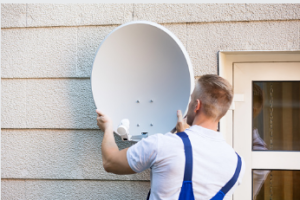Choosing the right TV antenna installation for your home can significantly affect how your television looks and feels. Several options are available, including a WiFi network that distributes signals to multiple locations or a Coaxial cable that covers just one, two, or three bands.
 Coaxial cable
Coaxial cable
Depending on the application, several coaxial cable types for TV antenna installation exist. Each one has different electrical characteristics.
The main advantages of coaxial cable for TV antenna installation are that it has a high-speed data capacity and is shielded from interference. It also can carry power from an antenna to a receiver. It can also be used for internet connectivity, computer networks, and digital audio (S/PDIF).
If the centre wire of a coaxial cable is too close to the shielding, the cable may experience interference. Internal reflections will also cause signal attenuation. In addition, a shorting signal can be introduced at improperly installed connectors.
Some coaxial lines use spacers to keep the inner conductor from getting too close to the shield. In addition, a solid Teflon (PTFE) insulator is used in plenum-rated cables.
The centre conductor of a coaxial cable is made of copper-clad steel and has high tensile strength. The outer shield is made of a metallic braid. The centre conductor is typically kept at ground potential, and the dielectric insulator surrounds the inner conductor and keeps the signal’s electric fields in the dielectric.
A cable for TV antenna installation is specially designed to protect the copper core from environmental conditions. However, its insulation may degrade over time and need to be replaced. Its insulation can also be damaged by water. Sealing the end of the cable is best to prevent moisture from entering.
Coaxial cable for TV antenna installation is available in many sizes. The most common coaxial cable for home use is RG-6. It has a nominal impedance of 75 ohms. However, it can carry speeds up to 10 Mbps.
The coaxial cable is usually terminated using RF connectors, usually nickel-plated or gold-plated with anti-corrosion properties. These connectors can be purchased from most manufacturers.
The cable has a thick round shape. The cable’s diameter should be 3 inches at maximum. It must also be bonded to its grounding system to prevent shock hazards. It also needs to be spliced securely onto its shield.
Locate true north
Using a magnetic compass to locate the true north is easier than you might think. The trick is to be prepared for the plethora of weather conditions that may occur to you. It is where a rubber weather boot and a quad shield cable come into play.
The same is true for a tamperproof mast. Using a tamperproof mast is the most secure way to ensure your mast atop your shack is intact in case of a smackdown.
The best part is you won’t have to sacrifice your wallet. Fortunately, a tamperproof mast costs a fraction of what it costs to replace the old one. It makes a tamperproof mast the sexiest home improvement project you’ll ever tackle. The only caveat is that you must buy the right mast for the right price. There are several options on the market. The best ones are those that are made of high-quality materials.
The best way to do this is to find a local home improvement store or specialist. It can be done in person or via online chat. You can then ask questions such as, “What is the best magnetic compass for my area?” “Is there a better way to affix your mast to your roof?” and “How can I make my antenna affixed to my roof?”
Cover one, two, or three bands
An antenna delivering a good signal should be positioned at least 16 feet away from a transmitter. This distance is based on the receiver’s sensitivity and transmitter power. The minimum distance is a good idea because it eliminates the risk of intermodulation of products in the receiver.
The FCC’s rule on antennas is a good place to start. The rule applies to antennas needed to receive service and restrictions on property owned or controlled by the antenna user.
The FCC rules on antennas are also applicable to state and local laws. The rules on antennas are similar to those on the property but do not apply to common areas of communities such as condominiums and cooperatives. Unless the rules are delineated, you might be in a situation where you cannot use your antenna.
It would help if you also remembered that some communities have specific written restrictions on antennas. In the best case, these restrictions are non-binding and can be ignored. However, the rules may delay your TV antenna installation in the worst case.
WiFi network distributes signals.
Using a WiFi network to distribute signals can allow you to watch live TV on multiple TVs simultaneously. So whether you have a smartphone, tablet, or laptop, a wireless network can allow you to watch the TV channels you want.
The first step in distributing signals is deciding what antenna you will use. You can choose between omnidirectional and directional antennas. An omnidirectional antenna has a larger coverage area and will work well indoors. However, it is limited by its range. You can also choose an external antenna, which works best outdoors. An external antenna will require a cable from the antenna to your TV.
You can also use a networked OTA receiver if you have a television with a tuner. These receivers will allow you to view live TV on multiple TVs. However, they do not have the functionality of cable or satellite TV. Nevertheless, they may be a good choice for many people.
